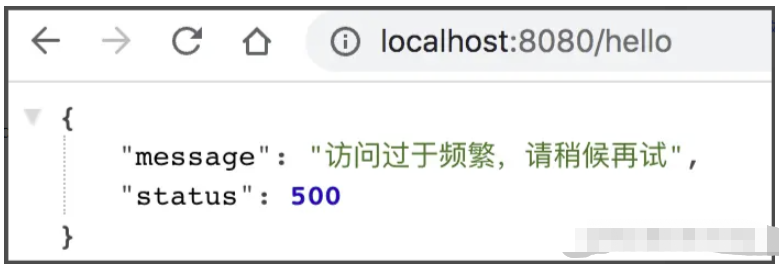本篇内容介绍了“如何使用SpringBoot + Redis实现接口限流”的有关知识,在实际案例的操作过程中,不少人都会遇到这样的困境,接下来就让小编带领大家学习一下如何处理这些情况吧!希望大家仔细阅读,能够学有所成!
配置
首先我们创建一个 Spring Boot 工程,引入 Web 和 Redis 依赖,同时考虑到接口限流一般是通过注解来标记,而注解是通过 AOP 来解析的,所以我们还需要加上 AOP 的依赖,最终的依赖如下:
<dependency> <groupId>org.springframework.boot</groupId> <artifactId>spring-boot-starter-data-redis</artifactId></dependency><dependency> <groupId>org.springframework.boot</groupId> <artifactId>spring-boot-starter-web</artifactId></dependency><dependency> <groupId>org.springframework.boot</groupId> <artifactId>spring-boot-starter-aop</artifactId></dependency>然后提前准备好一个 Redis 实例,这里我们项目配置好之后,直接配置一下 Redis 的基本信息即可,如下:
spring.redis.host=localhostspring.redis.port=6379spring.redis.password=123限流注解
接下来我们创建一个限流注解,我们将限流分为两种情况:
针对当前接口的全局性限流,例如该接口可以在 1 分钟内访问 100 次。
针对某一个 IP 地址的限流,例如某个 IP 地址可以在 1 分钟内访问 100 次。
针对这两种情况,我们创建一个枚举类:
public enum LimitType { DEFAULT, IP}接下来我们来创建限流注解:
@Target(ElementType.METHOD)@Retention(RetentionPolicy.RUNTIME)@Documentedpublic @interface RateLimiter { String key() default "rate_limit:"; int time() default 60; int count() default 100; LimitType limitType() default LimitType.DEFAULT;}第一个参数限流的 key,这个仅仅是一个前缀,将来完整的 key 是这个前缀再加上接口方法的完整路径,共同组成限流 key,这个 key 将被存入到 Redis 中。
另外三个参数好理解,我就不多说了。
好了,将来哪个接口需要限流,就在哪个接口上添加 @RateLimiter 注解,然后配置相关参数即可。
定制 RedisTemplate
在 Spring Boot 中,我们其实更习惯使用 Spring Data Redis 来操作 Redis,不过默认的 RedisTemplate 有一个小坑,就是序列化用的是 JdkSerializationRedisSerializer,不知道小伙伴们有没有注意过,直接用这个序列化工具将来存到 Redis 上的 key 和 value 都会莫名其妙多一些前缀,这就导致你用命令读取的时候可能会出错。
例如存储的时候,key 是 name,value 是 test,但是当你在命令行操作的时候,get name 却获取不到你想要的数据,原因就是存到 redis 之后 name 前面多了一些字符,此时只能继续使用 RedisTemplate 将之读取出来。
我们用 Redis 做限流会用到 Lua 脚本,使用 Lua 脚本的时候,就会出现上面说的这种情况,所以我们需要修改 RedisTemplate 的序列化方案。
可能有小伙伴会说为什么不用 StringRedisTemplate 呢?StringRedisTemplate 确实不存在上面所说的问题,但是它能够存储的数据类型不够丰富,所以这里不考虑。
修改 RedisTemplate 序列化方案,代码如下:
@Configurationpublic class RedisConfig { @Bean public RedisTemplate<Object, Object> redisTemplate(RedisConnectionFactory connectionFactory) { RedisTemplate<Object, Object> redisTemplate = new RedisTemplate<>(); redisTemplate.setConnectionFactory(connectionFactory); // 使用Jackson2JsonRedisSerialize 替换默认序列化(默认采用的是JDK序列化) Jackson2JsonRedisSerializer<Object> jackson2JsonRedisSerializer = new Jackson2JsonRedisSerializer<>(Object.class); ObjectMapper om = new ObjectMapper(); om.setVisibility(PropertyAccessor.ALL, JsonAutoDetect.Visibility.ANY); om.enableDefaultTyping(ObjectMapper.DefaultTyping.NON_FINAL); jackson2JsonRedisSerializer.setObjectMapper(om); redisTemplate.setKeySerializer(jackson2JsonRedisSerializer); redisTemplate.setValueSerializer(jackson2JsonRedisSerializer); redisTemplate.setHashKeySerializer(jackson2JsonRedisSerializer); redisTemplate.setHashValueSerializer(jackson2JsonRedisSerializer); return redisTemplate; }}这个其实也没啥好说的,key 和 value 我们都使用 Spring Boot 中默认的 jackson 序列化方式来解决。
Lua 脚本
这个其实我在之前 vhr 那一套视频中讲过,Redis 中的一些原子操作我们可以借助 Lua 脚本来实现,想要调用 Lua 脚本,我们有两种不同的思路:
在 Redis 服务端定义好 Lua 脚本,然后计算出来一个散列值,在 Java 代码中,通过这个散列值锁定要执行哪个 Lua 脚本。
直接在 Java 代码中将 Lua 脚本定义好,然后发送到 Redis 服务端去执行。
Spring Data Redis 中也提供了操作 Lua 脚本的接口,还是比较方便的,所以我们这里就采用第二种方案。
我们在 resources 目录下新建 lua 文件夹专门用来存放 lua 脚本,脚本内容如下:
local key = KEYS[1]local count = tonumber(ARGV[1])local time = tonumber(ARGV[2])local current = redis.call('get', key)if current and tonumber(current) > count then return tonumber(current)endcurrent = redis.call('incr', key)if tonumber(current) == 1 then redis.call('expire', key, time)endreturn tonumber(current)这个脚本其实不难,大概瞅一眼就知道干啥用的。KEYS 和 ARGV 都是一会调用时候传进来的参数,tonumber 就是把字符串转为数字,redis.call 就是执行具体的 redis 指令,具体流程是这样:
首先获取到传进来的 key 以及 限流的 count 和时间 time。
通过 get 获取到这个 key 对应的值,这个值就是当前时间窗内这个接口可以访问多少次。
如果是第一次访问,此时拿到的结果为 nil,否则拿到的结果应该是一个数字,所以接下来就判断,如果拿到的结果是一个数字,并且这个数字还大于 count,那就说明已经超过流量限制了,那么直接返回查询的结果即可。
如果拿到的结果为 nil,说明是第一次访问,此时就给当前 key 自增 1,然后设置一个过期时间。
最后把自增 1 后的值返回就可以了。
其实这段 Lua 脚本很好理解。
接下来我们在一个 Bean 中来加载这段 Lua 脚本,如下:
@Beanpublic DefaultRedisScript<Long> limitScript() { DefaultRedisScript<Long> redisScript = new DefaultRedisScript<>(); redisScript.setScriptSource(new ResourceScriptSource(new ClassPathResource("lua/limit.lua"))); redisScript.setResultType(Long.class); return redisScript;}可以啦,我们的 Lua 脚本现在就准备好了。
注解解析
接下来我们就需要自定义切面,来解析这个注解了,我们来看看切面的定义:
@Aspect@Componentpublic class RateLimiterAspect { private static final Logger log = LoggerFactory.getLogger(RateLimiterAspect.class); @Autowired private RedisTemplate<Object, Object> redisTemplate; @Autowired private RedisScript<Long> limitScript; @Before("@annotation(rateLimiter)") public void doBefore(JoinPoint point, RateLimiter rateLimiter) throws Throwable { String key = rateLimiter.key(); int time = rateLimiter.time(); int count = rateLimiter.count(); String combineKey = getCombineKey(rateLimiter, point); List<Object> keys = Collections.singletonList(combineKey); try { Long number = redisTemplate.execute(limitScript, keys, count, time); if (number==null || number.intValue() > count) { throw new ServiceException("访问过于频繁,请稍候再试"); } log.info("限制请求'{}',当前请求'{}',缓存key'{}'", count, number.intValue(), key); } catch (ServiceException e) { throw e; } catch (Exception e) { throw new RuntimeException("服务器限流异常,请稍候再试"); } } public String getCombineKey(RateLimiter rateLimiter, JoinPoint point) { StringBuffer stringBuffer = new StringBuffer(rateLimiter.key()); if (rateLimiter.limitType() == LimitType.IP) { stringBuffer.append(IpUtils.getIpAddr(((ServletRequestAttributes) RequestContextHolder.currentRequestAttributes()).getRequest())).append("-"); } MethodSignature signature = (MethodSignature) point.getSignature(); Method method = signature.getMethod(); Class<?> targetClass = method.getDeclaringClass(); stringBuffer.append(targetClass.getName()).append("-").append(method.getName()); return stringBuffer.toString(); }}这个切面就是拦截所有加了 @RateLimiter 注解的方法,在前置通知中对注解进行处理。
首先获取到注解中的 key、time 以及 count 三个参数。
获取一个组合的 key,所谓的组合的 key,就是在注解的 key 属性基础上,再加上方法的完整路径,如果是 IP 模式的话,就再加上 IP 地址。以 IP 模式为例,最终生成的 key 类似这样:
rate_limit:127.0.0.1-org.javaboy.ratelimiter.controller.HelloController-hello(如果不是 IP 模式,那么生成的 key 中就不包含 IP 地址)。将生成的 key 放到集合中。
通过 redisTemplate.execute 方法取执行一个 Lua 脚本,第一个参数是脚本所封装的对象,第二个参数是 key,对应了脚本中的 KEYS,后面是可变长度的参数,对应了脚本中的 ARGV。
将 Lua 脚本执行的结果与 count 进行比较,如果大于 count,就说明过载了,抛异常就行了。
接口测试
接下来我们就进行接口的一个简单测试,如下:
@RestControllerpublic class HelloController { @GetMapping("/hello") @RateLimiter(time = 5,count = 3,limitType = LimitType.IP) public String hello() { return "hello>>>"+new Date(); }}每一个 IP 地址,在 5 秒内只能访问 3 次。
这个自己手动刷新浏览器都能测试出来。
全局异常处理
由于过载的时候是抛异常出来,所以我们还需要一个全局异常处理器,如下:
@RestControllerAdvicepublic class GlobalException { @ExceptionHandler(ServiceException.class) public Map<String,Object> serviceException(ServiceException e) { HashMap<String, Object> map = new HashMap<>(); map.put("status", 500); map.put("message", e.getMessage()); return map; }}这是一个小 demo,我就不去定义实体类了,直接用 Map 来返回 JSON 了。 最后我们看看过载时的测试效果:

“如何使用SpringBoot + Redis实现接口限流”的内容就介绍到这里了,感谢大家的阅读。如果想了解更多行业相关的知识可以关注编程网网站,小编将为大家输出更多高质量的实用文章!





